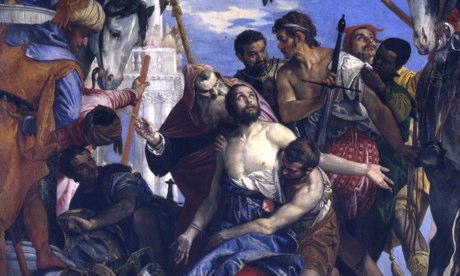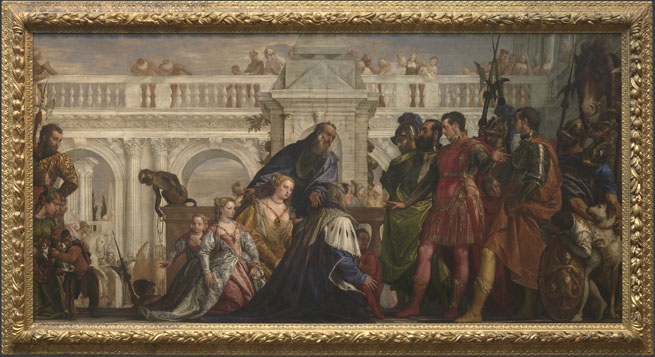 The artist in question is about to get an exhibition at the National Gallery (yes, I’m still inspired by goings-on in London) — and he is Veronese. Apparently, when the NG bought Veronese’s The Family of Darius before Alexander (below right) in 1857, it was accused of squandering money on “a second-rate specimen of a second-rate artist.”
The artist in question is about to get an exhibition at the National Gallery (yes, I’m still inspired by goings-on in London) — and he is Veronese. Apparently, when the NG bought Veronese’s The Family of Darius before Alexander (below right) in 1857, it was accused of squandering money on “a second-rate specimen of a second-rate artist.”
Of course, we don’t think of Veronese as second-rate today, though — and I hate to say this, as I love his work — he came off in third place a few years back, when the Museum of Fine Arts in Boston gave us the marvelous exhibition, Titian, Tintoretto, Veronese:Â Rivals in Renaissance Venice. (Curators, by their choices, can make us believe what they believe.)
Anyway, the National Gallery will on Mar. 19 open Veronese: Magnificence in Renaissance Venice, the first monographic show for him in the U.K., and — thanks to The Guardian — we know the back story, including the 1857 contretemps and, more important, director Nicholas Penny’s position on it (he thinks it’s one of the greatest paintings in the NG’s collection).
Penny thinks another painting in the show, The Martyrdom of St. George, is “arguably the world’s greatest painting” — it’s above left. The remark gains weight when The Guardian adds that so does the exhibition curator, Xavier Salomon — who is about to leave his curatorial post at the Metropolitan Museum, where he moved from the NG Dulwich Picture Gallery just a couple of years ago, to the Frick, where he will be chief curator.
 Salomon told The Guardian: “Without Veronese there would be no Rubens, no Van Dyck.”
Salomon told The Guardian: “Without Veronese there would be no Rubens, no Van Dyck.”
If only Salomon could bring his show to New York! Here is a description of part of it:
…the paintings that are coming will make an extraordinary exhibition, Salomon says. The show will reunite works not seen together since their days in the artist’s studio, including dazzling secular portraits and two altarpieces made for the same church near Mantua, now in London and Virginia, USA. Mars and Venus United by Love, coming from the Metropolitan Museum in New York, – and leaving the States for the first time since 1910 – will be seen with the National’s Four Allegories of Love, last seen together in the 18th century. Another National favourite, The Adoration of the Kings– one of its all-time best-selling Christmas cards – will be compared with another altarpiece on the same subject, painted in the same year for a church in Vicenza.
In a YouTube video, which is excellent, Salomon says he focused on Veronese’s most beautiful works — about 50 works in all, including the NG’s ten and paintings from Austria, France, Italy, Spain and the U.S. Some of the loans are still being negotiated.
You can also see the NG’s exhibition slide show here.
The press release makes no mention of the show traveling, though it does refer to its association with the Museo di Castelvecchio, Verona, and its exhibition Paolo Veronese beginning on July 5.
But, still, Xavier, couldn’t something, some part of it come here to the Frick?
